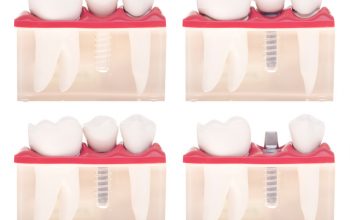


Dental problems are rampant in the United States. There are more than 30 million people who have lost all of their teeth on at least one jaw. At least 15 million of these people have gotten bridges or crowns for at least some of these missing teeth. An estimated 15% of the American edentulous population goes in to have dentures made every year. The problem is nearly three-quarters of all people in the country, or 74%, think having a good smile is very important to career success. For people who would rather not go the crown or denture routes, there is another way to replace missing teeth. Dental implants look the most like natural teeth. But, “what are dental implants?” you ask. Read on to learn more.
What Are Dental Implants?
Quite simply, they are replacement teeth roots. Unlike dentures and traditional bridges, when implants are put in by a dental implant dentist, they do not impact the other, surrounding teeth and they do not slip or move. Dentures are affixed to the gum with an adhesive. This can be good and is an option but it also means food particles can get in between the gum and the denture, which can cause pain and discomfort. These are removed and cleaned at night. Traditional bridges are affixed to the gum by being anchored to the teeth around the missing teeth. This means if you have one missing tooth, the two teeth around it are shaved down and the bridge is affixed to that. At the end of the procedure all teeth look natural.
What are dental implants? A better solution for a lot of people. They have a success rate of nearly 98% and are the closest thing you can do to replace teeth with something that looks the most natural. In Europe, they are so popular that the market for then is expected to grow to $4.2 billion by 2022.
What is the cost of dental implants?
The dental implant cost varies based on where you are in the country and from dentist to dentist. The cost has been coming down in recent years and many dentists offer payment plans and other ways to help people get new teeth. Financing may be available. Insurance companies are coming around to the benefits of dental implants so more and more carriers are including them in their dental plans. You should talk to your insurance carrier to find out if they do cover dental implants.
What is the process for dental implants?
- The first thing the dentist or oral surgeon will do is remove whatever is left of the bad tooth. Just because it is missing from the surface does not mean the root and nerve are not still there. The first thing, therefore, that needs to be done is get rid of that.
- Next the dental expert takes an x-ray of the jaw area where the implant would be put in. They need to make sure the patient has enough bone to support the metal implant that takes the place of the tooth root. Unfortunately, while most people have enough bone, some people do not.
- After the area has healed, a surgery is scheduled to place the metal stud in the jaw. This is the replacement tooth root to which a crown will be attached. After this procedure, the patient goes home to recuperate.
- After this has done healing, the patient returns and a crown is added to the implant. This completes the whole shebang and the patient how has a tooth that has been crafted to match the rest of their teeth. Another answer to the question, “what are dental implants?” could be, “a great solution for many people who need to get replacement teeth and restore their smile.”
Dental implants are a great option for a large number of people. Their low failure rate means patients do not have to worry so much about that tooth or those teeth. They also are the most natural looking and closest thing patients can get to getting new real teeth that is available on the market today.
More and more people are turning to dental implants as a good option to replace their missing teeth. People who are considering getting dental implants should call their dentist and request a consultation.



